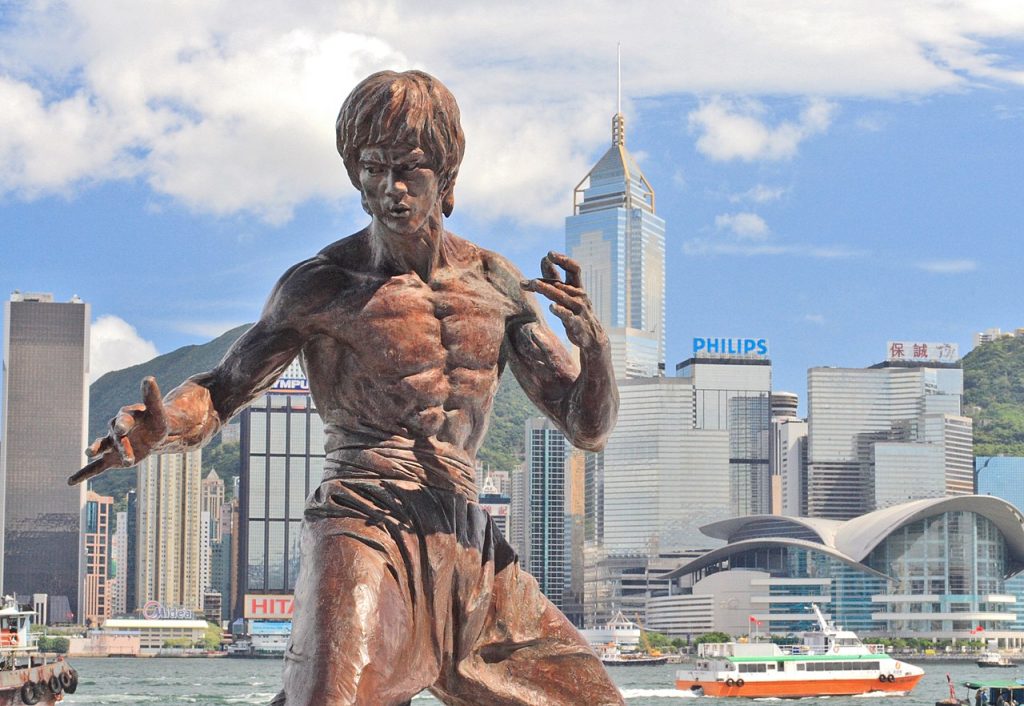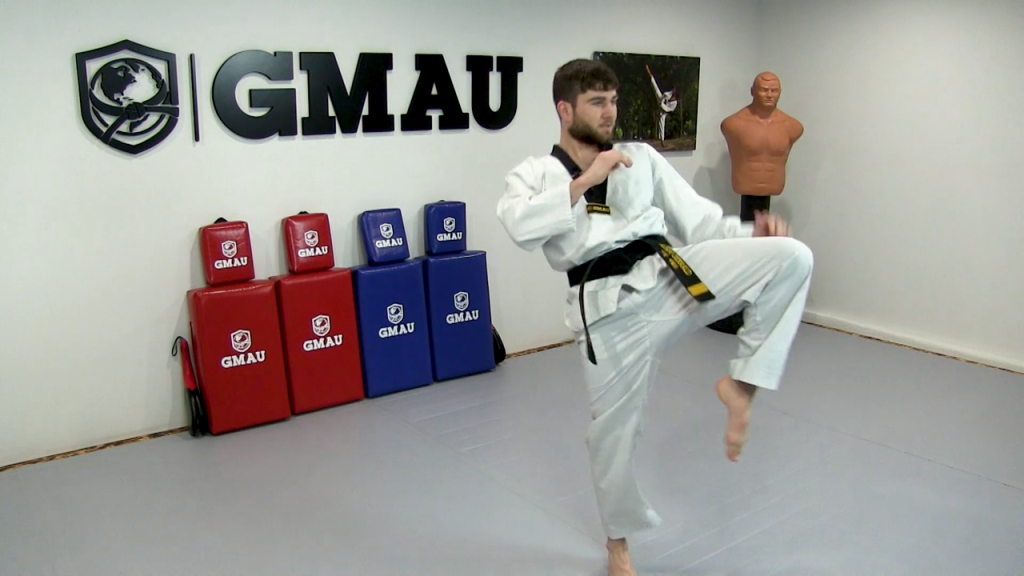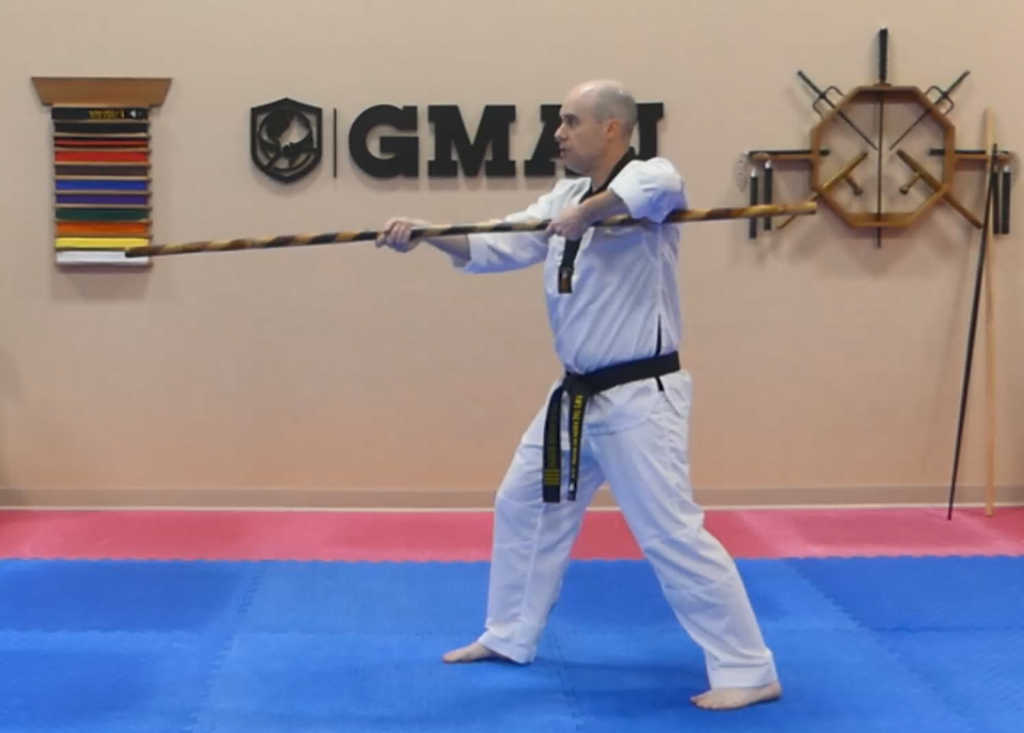When beginning any martial art, most of us want to get right to the “good stuff” … Punching … Kicking … Fighting! And that’s where we put our focus. But that can be to the detriment of proper footwork. If you have unsound footwork you’ll literally be stuck and predictable.
Want some great tips on footwork essentials? Then keep reading and get sage advice from our GMAU instructors!
“The quality of a man’s technique depends on his footwork, for one cannot use his hands or kicks efficiently until his feet have put him in the desired position. If a man is slow on his feet, he will be slow with his punches and kicks. Mobility and speed of footwork precede speed of kicks and punches.”
– Bruce Lee, Tao of Jeet Kune Do

Footwork is the most fundamental aspect of any martial art. No technique will be effective without you first getting into the right position (and range). Footwork allows you to move into more advantageous positions while preventing your opponent from doing the same.
Proper footwork provides balance, speed, power, and control; it’s both offensive and defensive. However, footwork does not always get the attention it needs.
In this article, you’ll hear from Global Martial Arts University (GMAU) instructors about the fundamentals of good footwork, and some drills you can do to hone it.
Let’s get to it!
Taekwondo
Taekwondo footwork focuses primarily on linear movement “in” to land strikes and kicks, and “out” to retreat out of range of counter attacks. Because Taekwondo uses a lot of kicks, footwork is also very important for setting up kicks and maintaining balance.

Tips from Sabumnim Adam Gerrald
- 40% of each class should focus on footwork.
- Never start off at a distance to hit (with hands).
- You must be able to close distance fast.
- Explosive speed is very important.
- Change speed when stationary and quickly change speed as you get closer to the opponent.
- Try to step on the other person’s foot.
- Use a “broken beat,” not a predictable rhythm in your movement.
- Bounce – don’t stand flat footed.
- Practice up and down, front to back.
- Keeps your muscles “awake” and engaged, not overly relaxed.
- Angling should also be practiced.
- Remember you can move forward faster than you can move backward.
- Try the “Zombie Drill” where you have to use footwork to avoid a training partner (no hands blocking).
- Focus on closing the distance and not getting hit.
Krav Maga
Krav Maga uses a mixture of footwork. It has a standard boxing stance for fighting (dominant hand “back”), and students work on the basics of footwork and angles. Different stances (dominant hand “forward”) are used for when a weapon is used for defense. Trainees also run a lot and learn awareness, because running away from a dangerous situation is the best defense.

Tips from Coach Dustin Koppel
- A good drill for when you’re first learning stance and movement is to close your eyes to determine where you’re off balance while moving around.
- Stress drills, and flashing lights for distractions.
- Basic running skills and being aware/ready to move at a moment’s notice.
- Weapon drills and distance training (which is controlled by footwork) are especially important in Krav Maga.
- Krav Maga is focused on self-defense and military combatives, therefore distance management of your opponent is critical.
- Stay out of reach of your opponent unless they engage you (or you decide to engage them); in either case you’ll end up very close to your opponent (within grappling range).
- Do not stay in punching or kicking range for extended periods of time. You’re either “all the way in” or “all the way out.”
- The characteristics of Krav Maga (footwork is key) must always be simulated in your practice and pressure testing.
Shotokan Karate
Footwork in Karate involves stepping in a straight line back and forward, or diagonally forward and backward, or turning to aid defense/blocking and offense/striking, and for controlling opponents during grappling, takedowns, or throwing.
A unique aspect of footwork in karate is that stepping, such as in kata, can represent low kicks, blocking with the legs, and tripping. These must be considered when practicing.

Tips from Sensei Sarah Hill
- Shotokan karate primarily uses linear footwork and is famous for its deep, long stances. It requires discipline and practice to condition the muscles and learn how to efficiently master moving through these stances.
- Familiarize yourself with and get a feel for each stance including foot positioning and weight distribution from a stationary position. Then practice moving through the stances.
- Understand where you should be in the middle of a transition. This helps you to make sure your footing and distribution will be correct as you change position without having to make unnecessary adjustments.
- Use masking tape on the floor to create a straight line to practice with. This will help you to check your alignment. This is particularly useful for moving through stances like kokutsu dachi (back stance) and kibba dachi (horse riding stance).
- When in zenkutsu dachi (front stance) be careful to keep the back foot at around a 35-degree angle, as your ankle mobility allows. Don’t get into the habit of letting your back foot turn out at 90 degrees, as this will slow you down by dragging the foot.
- Try to use a gliding step as much as possible, using the outside of the ball of the foot and the big toe. You will develop callouses over time that will help with this.
- The shortest distance between two points is a straight line. Learn how to step through your stance when changing positions rather than around it. When stepping through kokutsu dachi, for example, your back foot should turn to face front and come through the center passing next to the front foot as it comes forward, rather than creating a large arc as it comes to the front.
Muay Thai
Muay Thai uses a lot of constant movement, so it’s critical that you invest time in practicing footwork. Muay Thai footwork is responsive, changing with the situation at hand. When you’re being offensive you move differently than when you’re being defensive. Once you understand footwork you’ll move more gracefully on the mat (or in the ring) and you’ll conserve energy (not “gas out”).

Tips from Coach Nick Vasallo
- Get the book entitled, “Muay Thai: The Footwork: The Secret to Learning the Art of 8 Limbs“. The first two chapters focus solely on footwork. The other chapters discuss important concepts built on footwork, e.g., stances, evasion.
- Focus on the importance of using all 8 limbs (punch, kick, elbow, knee – right and left sides).
- Practice being positioned correctly for fighting (footwork, stances, angles).
- Remember that the lower body (legs) also “jab”, so legs are used differently than in boxing.
Ultimate Bo
Kobudo (Japanese weapons styles) requires many of the same physical skills of empty-hand martial arts training. The stances and body dynamics are similar: both include blocking and striking techniques, and both require suppleness and strength. Good stances and footwork are a must, and the feet must be in coordination with the hands or the weapon becomes less effective.
It takes more time to develop total body coordination with a weapon, and footwork and stances are foundational.

Tips from Sensei Nathan Douglas
- When using a weapon, as in Ultimate Bo (Bojutsu), footwork is closely tied with stances. For example, the long front stance enables you to have significantly more power and stability. This stance is relatively narrow, aligning the body behind a thrust, for example.
- In Kobudo, we use similar footwork to Karate, Taekwondo, and Kickboxing.
- As with “empty hand” fighting, you clearly keep more of a distance between you and your opponent to stay out of range of his/her weapon.
- Similarly, you have to use footwork and timing to close the distance for your own strikes, blocks, thrusts, and pokes.
Conclusion
As you we’ve discussed, above, there are a lot of footwork-related commonalities across different martial arts: control distance, avoid the opponent’s attack, and put your weapon in range and stay away from theirs.
There are some differences, as well. Taekwondo works from long-to-medium range for punches and kicks while not being suppressed by the close range. Whereas Krav Maga works from long range to very close range with little time spent in the middle range.
The GMAU’s coaches and instructors encourage you to consider the similarities and differences between the arts you study and others.
For more information on footwork check out these resources:
Footwork Wins Fights: The Footwork of Boxing, Kickboxing, Martial Arts & MMA
Staff, Baton & Longsword Combat Series: Understanding and Developing Footwork
Muay Thai: The Footwork: The Secret to Learning the Art of 8 Limbs









